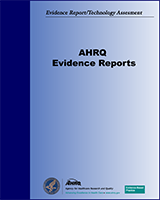NCBI Bookshelf. A service of the National Library of Medicine, National Institutes of Health.
Levine CB, Fahrbach KR, Siderowf AD, et al. Diagnosis and Treatment of Parkinson's Disease: A Systematic Review of the Literature. Rockville (MD): Agency for Healthcare Research and Quality (US); 2003 Jun. (Evidence Reports/Technology Assessments, No. 57.)
This publication is provided for historical reference only and the information may be out of date.

Diagnosis and Treatment of Parkinson's Disease: A Systematic Review of the Literature.
Show detailsThe strengths of this review include the clear definition of the research questions, adherence to an explicit research protocol developed prior to the analysis, the comprehensive nature of the data search (employing both electronic databases and manual bibliography searches, resulting in the inclusion of all relevant published materials), and the requirement that consensus be reached by two reviewers on all data elements prior to entry into the database.
Another primary strength of this evidence base is the collaboration of multidisciplinary researchers who participated in its development. It was compiled by investigators who are skilled in employing highly systematic and unbiased methods to collect, review and synthesize data from published clinical literature. Throughout the course of this project, there was frequent input from the co-investigator (a clinical content expert) and the TEP. In addition, the final report has benefited from input from the TEP and peer reviewers.
The major limitations of this review are related to weaknesses inherent in the available published literature on the management of PD. While the prevalence of PD is reportedly almost equal in males and females, the studies were composed predominantly of males. This was particularly true for studies in which patients with advanced disease were evaluated. Patients with age of disease onset prior to 50 years, an important subset of PD patients, were largely absent from the database. The exclusion criteria for most studies were extensive, excluding most patients with comorbidities. This brings the generalizability of results into question.
While most studies reported PD scale results, these results were reported in a wide variety of formats. Reliance on figures to show data and trends in the data was common. While these methods may be useful for the purposes of explaining data in primary studies, they interfere with the ability to statistically amass a body of evidence over time. “On-off” time, which is an important measure of treatment efficacy, particularly in patients with advanced PD, was described with such wide variation that the results from different studies could not be combined in a meaningful way.
Many studies were excluded from this Evidence Report due to insufficient study duration or cross-over design. While we recognize that strict application of inclusion and exclusion criteria caused some pertinent and potentially useful studies to be excluded, an essential element of a systematic review is to apply uniform criteria that were established a priori. The investigators believe that even with these restrictions, a sufficient number of studies met inclusion criteria to address all of the questions posed in this Task Order. Studies that did not meet inclusion criteria but were deemed important for discussion in this evidence report were addressed in Appendix J, although formal data extraction and statistical analyses were not performed on these studies.
Another limitation of this Evidence Report is that it was limited to published studies only. As studies with unfavorable results are often not published, the efficacy of a particular treatment, such as surgery, may appear falsely elevated.
- Strengths and Limitations of the Evidence Base - Diagnosis and Treatment of Park...Strengths and Limitations of the Evidence Base - Diagnosis and Treatment of Parkinson's Disease
- Appendix B. Graphic Summaries - Milk Thistle: Effects on Liver Disease and Cirrh...Appendix B. Graphic Summaries - Milk Thistle: Effects on Liver Disease and Cirrhosis and Clinical Adverse Effects
- PREDICTED: Homo sapiens uncharacterized lncRNA (LOC105375170), transcript varian...PREDICTED: Homo sapiens uncharacterized lncRNA (LOC105375170), transcript variant X3, ncRNAgi|2217369424|ref|XR_927067.3|Nucleotide
- References - Rehabilitation for Traumatic Brain InjuryReferences - Rehabilitation for Traumatic Brain Injury
- Preface - Rehabilitation for Traumatic Brain InjuryPreface - Rehabilitation for Traumatic Brain Injury
Your browsing activity is empty.
Activity recording is turned off.
See more...